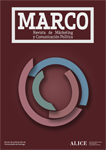Estratexias de campaña electoral centradas nas características persoais do candidato A imaxe de proximidade no caso de Jorge Yunda Machado
Contido principal do artigo
Resumo
La presente nota de campaña analiza cualitativamente, los rasgos de la imagen política del candidato a la Alcaldía de Quito, Jorge Yunda Machado, y cómo se configura para mostrar un político humano y cercano con los electores. Para tal efecto se toman en cuenta las fotografías y vídeos publicados en la página web http://jorgeyunda.com.ec , así como una entrevista con la asesora de la campaña.Para este caso particular, se hace referencia a las características de la propaganda, la utilización de recursos iconográficos y el discurso que enfatiza los orígenes humildes de Yunda. La fundamentación de esta nota, se basa en los aportes de Canel (2008) referidos a la configuración de la imagen del candidato, la tipología de propaganda de D’Adamo y García Beaudoux (2011) y las definiciones de Annunziata (2011) referidas a la proximidad política, como una nueva forma de plasmar campañas electorales.
Palabras chave
Detalles do artigo
Citas
ANNUNZIATA, R. (2011). «Proximidad», representación y participación. El Presupuesto Participativo en Argentina. Iconos. Revista de Ciencias Sociales. Num. 40, Quito, mayo 2011, pp. 57-70, recuperado el 17.10.2017 en http://www.fl acso.org.ec/docs/i40annunziata.pdf.
ANNUNZIATA, R. (2018). “Si viene, yo lo voto”: la proximidad en timbreos y visitas de Mauricio Macri durante la campaña electoral y su primer año de gobierno (20152016). Austral Comunicación. Volumen 7, número 1 (junio de 2018): 57-90. ISSN 2313-9129 DOI: https://doi.org/10.26422/aucom.2018.0701.ann
BARRAGÁN, A. (2017). Propaganda Fotográfi ca, la imagen al servicio del poder. ADVOOK. España.
BERROCAL S. (2004). Una aproximación a la nueva retórica del líder político televisivo: acciones, cualidades y discurso. doxa comunicación Nº2 http://opendata.dspace.ceu.es/bitstream/10637/5989/1/N%c2%baII_pp53_67.pdf
CABRERA GARCÍA-OCHOA, Y., & LLORCA, G. (2019). La imagen de los candidatos en las Elecciones Generales de 2019 en España. Redmarka. Revista De Marketing Aplicado, 23(3), 29-45. https://doi.org/10.17979/redma.2019.23.3.5875
CANEL, M. (2008), Comunicación Política, una guía para su estudio y práctica, segunda edición, Madrid (España), Tecnos.
DURÁN, J. NIETO, S. (2010). El arte de ganar. Cómo usar el ataque en campañas electorales exitosas. DEBATE. Argentina.
GARCÍA, V., D`ADAMO, O. y otros (2011), Propaganda gubernamental. Tácticas e iconografías del poder, Buenos Aires (Argentina), Ediciones La Crujía.
GORDO, A Y SERRANO, A. (2008). Estrategias y prácticas cualitativas de investigación social. PEARSON EDUCACIÓN, S.A., Madrid.
LOSADA, J. (2009). La imagen del candidato: los atributos para la marca de un político. En R. Zamora (coord.), El candidato marca. Como gestionar la imagen del líder político (pp.51-68). Editorial Fragua, Madrid.
MIELES, M., TONON, G., Y ALVARADO, S. (2012). Investigación cualitativa: el análisis temático para el tratamiento de la información desde el enfoque de la fenomenología social. Universitas Humanística, (74), 195-225.
PAGUAY CHÁVEZ, F. W., VÁSQUEZ-CADENA, C. A., & MÁRQUEZ-DOMÍNGUEZ, C. (2020). Ausentismo, indecisión y campañas digitales en la carrera hacia las alcaldías 2019 en Ecuador. MARCO (Márketing Y Comunicación Política), 5. https://doi.org/10.15304/marco.5.6470.
QUECEDO, R., & CASTAÑO, C. (2002). Introducción a la metodología de investigación cualitativa. Revista de Psicodidáctica, 14, 5–39. http://www.redalyc.org/ html/175/17501402/%0Ahttp://www.redalyc.org/resumen.oa?id=17501402
SUSANO GARCÍA, J. L. (2018). El Slogan Politico Una Estrategia De Comunicación Y Marketing De “El Bronco” Para Incidir En Las Elecciones De Nuevo León, México. Marco (Márketing Y Comunicación Política), 4, 69-82. https://doi.org/10.15304/marco.4.4301.
TRINDADE, A. (2016). Entrevistando en investigación cualitativa y los imprevistos en el trabajo de campo: de la entrevista semi estructurada a la entrevista no estructurada. En Schettini, P. Cortazzo I. (Coordinadoras). Técnicas y estrategias en la investigación cualitativa. Editorial de la Universidad de la Plata. Argentina.
VIOUNNIKOFF-BENET, N. (2018). La imagen del candidato en la era digital. Como gestionar la escenografía política. Editorial UOC. Barcelona.






